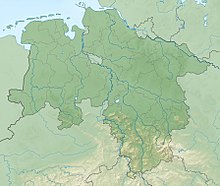Warningsacker
Coordinates: 53 ° 47 ′ 51.9 " N , 8 ° 50 ′ 47.7" E
The Warning Sacker was from the Middle Ages until well into the modern era, the historic Landtagsplatz the country Hadeln , a former peasant republic in the northern Elbe-Weser triangle . Here the representatives of all parishes , the Hadler estates , gathered in the open air to discuss legal and governmental matters together. The place still exists today and is located a little inconspicuously southeast of Cuxhaven - Altenbruch , near the municipality border to Otterndorf on the federal road 73 .
description
The name probably goes back to the proper name Warn , a Low German variant of the name Werner (see: English: Warren ), i.e. the name of the locator who settled the first Holler colonists here in order to reclaim the marshland . It is possible that the verbs were and will also sound , in the sense of: "observe (the laws), preserve". Older forms of the name are Warensacker (1481), Wardennsacker (1496), Warings-Acker (1615) or Warenschradendeill , where "Schraden" is a cut piece of land. Deel or part is the name for a part of the parish that comprised around 40 to 50 fire places and was represented by its own "authorized representative".
In 1909, a new linden tree was planted in place of the multi-century linden tree that collapsed in 1895. In addition, the site is now marked with an information board and a stone monument from 1909 that bears the inscription THINGSTÄTTE WARNINGSACKER . However , it has not been proven whether there was actually a thing place here .
Origin and location
Even if the Warningsacker is only explicitly mentioned as a state parliament place in 1496, one can assume that the previous state parliaments also took place here. Already in a document from 1329 there is explicit mention of a people's assembly. The oldest document, in which the entirety of all residents of the state of Hadeln ( universi Hadelerie inhabitantes ) is listed as contractual partners (with the city of Lübeck ), dates from 1298.
The square was about halfway between Altenbruch, the old suburb of the seven parishes of the Hadler highlands and the Otterndorf Castle, in which a count , as governor of the Duke of Saxony-Lauenburg , had presided over the upper court since 1387 at the latest .
Occasions for state parliaments
Important reasons for convening the state assembly were the hereditary homage of the estates when a new sovereign ruler took office. The duke usually appeared in person and had to confirm to the estates their old privileges, the parish constitution and the church order each time. When his representatives in 1575 z. B. proposed to abolish the parish courts, or wanted to introduce a new land law in 1619, this was rejected by the Hadlers. Otherwise, the dukes often appeared as petitioners in order to obtain funds (1530 to rebuild the burnt down Otterndorf Palace, 1586 a grain duty, 1615 for the fortification of the Otterndorf Palace, 1617 to rebuild the burnt down Lauenburg Palace, 1660 for armaments and other military expenses , 1683 for the trousseau of a princess). One-off payments were mostly approved by the stands (after they had traded them down), but new taxes were generally rejected. In addition, the Landtag was also convened when there was a threat of war and to draft the Hadler Landwehr, or when the land law was changed (abolition of Wergelde in 1558 ).
After the Dukes of Saxony-Lauenburg died out in 1689, the Count was replaced by an imperial commissioner who confirmed the old privileges in the name of Leopold I. The following year, the Hadler decided to throw the remaining troops from the Electorate of Saxony out of the country, if necessary by force of arms (which was not necessary). In 1716 and 1717 new special taxes were decided on the Warningsacker, first a Turkish tax , then contributions to repair the severe damage caused by the great Christmas flood, and in 1722 additional taxes.
The last hereditary homage on the Warningsacker took place in 1731 after the land of Hadeln fell to Kurhannover . The last count was presented to the stands on Warningsacker in 1799, after which the office was never filled again.
literature
- Ernst Dieterichs: The Warningsacker, the Landtagplatz of the free state of Hadeln. An overview of the Hadelner self-administration. in: Stader Yearbook 1955 (Stader Archive New Series 45) pp. 103–126
- Chronicle of the municipality of Nordleda, special edition by Volksbank Cuxhaven-Hadeln eG, Nordleda 12/1995, 242 pages

